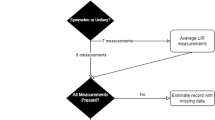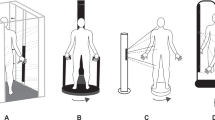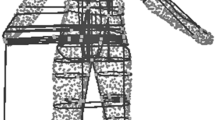Abstract
Background
The precision of digital anthropometry through 3-dimensional (3D) scanning has been established for relatively large, expensive, non-portable systems. The comparative performance of modern mobile applications is unclear.
Subjects/methods
Forty-six adults (age: 23.3 ± 5.3 y; BMI: 24.4 ± 4.1 kg/m2) were assessed in duplicate using: (1) a mobile phone application capturing two individual 2D images, (2) a mobile phone application capturing serial images collected during a subject’s complete rotation, (3) a traditional scanner with a time of flight infrared sensor collecting visual data from a subject being rotated on a mechanical turntable, and (4) a commercial measuring booth with structured light technology using 20 infrared depth sensors positioned in the booth. The absolute and relative technical error of measurement (TEM) and intraclass correlation coefficient (ICC) for each method were established.
Results
Averaged across circumferences, the absolute TEM, relative TEM, and ICC were (1) 0.9 cm, 1.5%, and 0.975; (2) 0.5 cm, 0.9%, and 0.986; (3) 0.8 cm, 1.5%, and 0.974; and (4) 0.6 cm, 1.1%, and 0.985. For total body volume, these values were (1) 2.2 L, 3.0%, and 0.978; (2) 0.8 L, 1.1%, and 0.997; (3) 0.7 L, 0.9%, and 0.998; and (4) 0.8 L, 1.1%, and 0.996, with segmental volumes demonstrating higher relative errors.
Conclusion
A 3D scanning mobile phone application involving full rotation of subjects in front of a smartphone camera exhibited similar reliability to larger, less portable, more expensive 3D scanners. In contrast, larger errors were observed for a mobile scanning application utilizing two 2D images, although the technical errors were acceptable for some applications.
This is a preview of subscription content, access via your institution
Access options
Subscribe to this journal
Receive 12 print issues and online access
$259.00 per year
only $21.58 per issue
Buy this article
- Purchase on Springer Link
- Instant access to full article PDF
Prices may be subject to local taxes which are calculated during checkout
Similar content being viewed by others
Data availability
Data may be available from the corresponding author upon reasonable request and pending relevant approvals.
References
Heymsfield SB, Bourgeois B, Ng BK, Sommer MJ, Li X, Shepherd JA. Digital anthropometry: a critical review. Eur J Clin Nutr. 2018;72:680–7. https://doi.org/10.1038/s41430-018-0145-7
Mocini E, Cammarota C, Frigerio F, Muzzioli L, Piciocchi C, Lacalaprice D, et al. Digital anthropometry: a systematic review on precision, reliability and accuracy of most popular existing technologies. Nutrients 2023;15:302. https://doi.org/10.3390/nu15020302
Graybeal AJ, Brandner CF, Tinsley GM. Visual body composition assessment methods: a 4-compartment model comparison of smartphone-based artificial intelligence for body composition estimation in healthy adults. Clin Nutr. 2022;41:2464–72. https://doi.org/10.1016/j.clnu.2022.09.014
Graybeal AJ, Brandner CF, Tinsley GM. Evaluation of automated anthropometrics produced by smartphone-based machine learning: a comparison with traditional anthropometric assessments. Br J Nutr. 2023;130:1077–87. https://doi.org/10.1017/s0007114523000090
Smith B, McCarthy C, Dechenaud ME, Wong MC, Shepherd J, Heymsfield SB. Anthropometric evaluation of a 3D scanning mobile application. Obesity. 2022;30:1181–8. https://doi.org/10.1002/oby.23434
Tinsley GM, Harty PS, Siedler MR, Stratton MT, Rodriguez C. Improved precision of 3-dimensional optical imaging for anthropometric measurement using non-rigid avatar reconstruction and parameterized body model fitting. Clin Nutr Open Sci. 2023;50:40–45. https://doi.org/10.1016/j.nutos.2023.07.002
Tinsley GM, Moore ML, Dellinger JR, Adamson BT, Benavides ML. Digital anthropometry via three-dimensional optical scanning: evaluation of four commercially available systems. Eur J Clin Nutr. 2020;74:1054–64. https://doi.org/10.1038/s41430-019-0526-6
Walter SD, Eliasziw M, Donner A. Sample size and optimal designs for reliability studies. Stat Med. 1998;17:101–10. https://doi.org/10.1002/(sici)1097-0258(19980115)17:1<101::aid-sim727>3.0.co;2-e
Arifin WN. Sample size calculator. Retrieved from http://wnarifin.github.io, 2023.
Shrout PE, Fleiss JL. Intraclass correlations: uses in assessing rater reliability. Psychol Bull. 1979;86:420–8. https://doi.org/10.1037//0033-2909.86.2.420
Koo TK, Li MY. A guideline of selecting and reporting intraclass correlation coefficients for reliability research. J Chiropr Med. 2016;15:155–63. https://doi.org/10.1016/j.jcm.2016.02.012
Wong MC, Ng BK, Kennedy SF, Hwaung P, Liu EY, Kelly NN, et al. Children and adolescents’ anthropometrics body composition from 3-D optical surface scans. Obesity. 2019;27:1738–49. https://doi.org/10.1002/oby.22637
Ng BK, Sommer MJ, Wong MC, Pagano I, Nie Y, Fan B, et al. Detailed 3-dimensional body shape features predict body composition, blood metabolites, and functional strength: the Shape Up! studies. Am J Clin Nutr. 2019;110:1316–26. https://doi.org/10.1093/ajcn/nqz218
Sullivan K, Metoyer CJ, Hornikel B, Holmes CJ, Nickerson BS, Esco MR, et al. Agreement between a 2-dimensional digital image-based 3-compartment body composition model and dual energy X-ray absorptiometry for the estimation of relative adiposity. J Clin Densitom. 2022;25:244–51. https://doi.org/10.1016/j.jocd.2021.08.004
Sullivan K, Hornikel B, Holmes CJ, Esco MR, Fedewa MV. Validity of a 3-compartment body composition model using body volume derived from a novel 2-dimensional image analysis program. Eur J Clin Nutr. 2022;76:111–8. https://doi.org/10.1038/s41430-021-00899-1
Fedewa MV, Sullivan K, Hornikel B, Holmes CJ, Metoyer CJ, Esco MR. Accuracy of a mobile 2D imaging system for body volume and subsequent composition estimates in a three-compartment model. Med Sci Sports Exerc. 2021;53:1003–9. https://doi.org/10.1249/mss.0000000000002550
Sobhiyeh S, Kennedy S, Dunkel A, Dechenaud ME, Weston JA, Shepherd J, et al. Digital anthropometry for body circumference measurements: toward the development of universal three-dimensional optical system analysis software. Obes Sci Pract. 2021;7:35–44. https://doi.org/10.1002/osp4.467
Harty PS, Sieglinger B, Heymsfield SB, Shepherd JA, Bruner D, Stratton MT, et al. Novel body fat estimation using machine learning and 3-dimensional optical imaging. Eur J Clin Nutr. 2020;74:842–5. https://doi.org/10.1038/s41430-020-0603-x
Tinsley GM. Five-component model validation of reference, laboratory and field methods of body composition assessment. Br J Nutr. 2021;125:1246–59. https://doi.org/10.1017/S0007114520003578
Tinsley GM, Moore ML, Benavides ML, Dellinger JR, Adamson BT. 3-dimensional optical scanning for body composition assessment: a 4-component model comparison of four commercially available scanners. Clin Nutr. 2020;39:3160–7. https://doi.org/10.1016/j.clnu.2020.02.008
Tinsley GM, Harty PS, Stratton MT, Smith RW, Rodriguez C, Siedler MR. Tracking changes in body composition: comparison of methods and influence of pre-assessment standardisation. Br J Nutr. 2022;127:1656–74. https://doi.org/10.1017/S0007114521002579
McCarthy C, Tinsley GM, Yang S, Irving BA, Wong MC, Bennett JP, et al. Smartphone prediction of skeletal muscle mass: model development and validation in adults. Am J Clin Nutr. 2023. https://doi.org/10.1016/j.ajcnut.2023.02.003
Kennedy S, Hwaung P, Kelly N, Liu YE, Sobhiyeh S, Heo M, et al. Optical imaging technology for body size and shape analysis: evaluation of a system designed for personal use. Eur J Clin Nutr. 2020;74:920–9. https://doi.org/10.1038/s41430-019-0501-2
Cabre HE, Blue MNM, Hirsch KR, Brewer GJ, Gould LM, Nelson AG, et al. Validity of a three-dimensional body scanner: comparison against a 4-compartment model and dual energy X-ray absorptiometry. Appl Physiol Nutr Metab. 2021;46:644–50. https://doi.org/10.1139/apnm-2020-0744
Ng BK, Hinton BJ, Fan B, Kanaya AM, Shepherd JA. Clinical anthropometrics and body composition from 3D whole-body surface scans. Eur J Clin Nutr. 2016;70:1265–70. https://doi.org/10.1038/ejcn.2016.109
Tian IY, Wong MC, Kennedy S, Kelly NN, Liu YE, Garber AK, et al. A device-agnostic shape model for automated body composition estimates from 3D optical scans. Med Phys. 2022. https://doi.org/10.1002/mp.15843
Wong MC, Ng BK, Tian I, Sobhiyeh S, Pagano I, Dechenaud M, et al. A pose-independent method for accurate and precise body composition from 3D optical scans. Obesity. 2021;29:1835–47. https://doi.org/10.1002/oby.23256
Ashby N, Jake LaPorte G, Richardson D, Scioletti M, Heymsfield SB, Shepherd JA, et al. Translating digital anthropometry measurements obtained from different 3D body image scanners. Eur J Clin Nutr. 2023;77:872–80. https://doi.org/10.1038/s41430-023-01289-5
Sobhiyeh S, Borel N, Dechenaud M, Graham CA, Wong M, Wolenski P, et al. Fully automated pipeline for body composition estimation from 3D optical scans using principal component analysis: a shape up study. Annu Int Conf IEEE Eng Med Biol Soc. 2020;2020:1853–8. https://doi.org/10.1109/embc44109.2020.9175211
Morse S, Talty K, Kuiper P, Scioletti M, Heymsfield SB, Atkinson RL, et al. Machine learning prediction of combat basic training injury from 3D body shape images. PLoS ONE. 2020;15:e0235017. https://doi.org/10.1371/journal.pone.0235017
Nelson R, Cheatham J, Gallagher D, Bigelman K, Thomas DM. Revisiting the United States Army body composition standards: a receiver operating characteristic analysis. Int J Obes. 2019;43:1508–15. https://doi.org/10.1038/s41366-018-0195-x
Harty PS, Friedl KE, Nindl BC, Harry JR, Vellers HL, Tinsley GM. Military body composition standards and physical performance: historical perspectives and future directions. J Strength Cond Res. 2022;36:3551–61. https://doi.org/10.1519/jsc.0000000000004142
Keith DS, Scherrer D, Nunley B, Boykin JR, Green JJ, Siedler MR, et al. Anthropometric predictors of conventional deadlift kinematics and kinetics: a preliminary study. Int J Exerc Sci. 2023;16:429–47.
Smith M, Turner D, Spencer C, Gist N, Ferreira S, Quigley K, et al. Body shape and performance on the US Army Combat Fitness Test: insights from a 3D body image scanner. PLoS ONE. 2023;18:e0283566. https://doi.org/10.1371/journal.pone.0283566
Bennett JP, Liu YE, Quon BK, Kelly NN, Leong LT, Wong MC, et al. Three-dimensional optical body shape and features improve prediction of metabolic disease risk in a diverse sample of adults. Obesity. 2022;30:1589–98. https://doi.org/10.1002/oby.23470
Pleuss JD, Talty K, Morse S, Kuiper P, Scioletti M, Heymsfield SB, et al. A machine learning approach relating 3D body scans to body composition in humans. Eur J Clin Nutr. 2019;73:200–8. https://doi.org/10.1038/s41430-018-0337-1
Funding
Funding for this study was provided by Greyscale Holdings, Inc. (DBA Prism Labs; Award #: A22-0305-001). Based on the research contract, the sponsor was able to review the present manuscript to ensure the technology was accurately described. Besides confirming the technical description of the scanning technology, the manufacturer played no role in the present manuscript, including the statistical analysis, writing, and decision to publish. A previous in-kind donation of the SS20 scanner (Size Stream, Cary, NC, USA) used in the present study allowed the research to proceed. This in-kind donation was unrelated to the present study, and this manufacturer had no role in any aspect of the present study.
Author information
Authors and Affiliations
Contributions
GMT designed the work; CR, MRS, ET, SJW, CL, AB, BD, and JR collected the data; GMT drafted the initial manuscript; all authors reviewed the manuscript for intellectual content, approved the manuscript, and agree to be accountable for the work.
Corresponding author
Ethics declarations
Competing interests
GMT has received in-kind support for his research laboratory, in the form of equipment loan or donation, from manufacturers of body composition assessment devices, including Size Stream LLC; Naked Labs, Inc.; Prism Labs, Inc.; RJL Systems; MuscleSound; and Biospace, Inc. None of these entities played a role in the present study, besides the financial support from Prism Labs described in the funding section.
Ethical approval
This study was approved by the Texas Tech University Institutional Review Board (IRB #2022-610), and all participants provided written informed consent prior to participation.
Additional information
Publisher’s note Springer Nature remains neutral with regard to jurisdictional claims in published maps and institutional affiliations.
Rights and permissions
Springer Nature or its licensor (e.g. a society or other partner) holds exclusive rights to this article under a publishing agreement with the author(s) or other rightsholder(s); author self-archiving of the accepted manuscript version of this article is solely governed by the terms of such publishing agreement and applicable law.
About this article
Cite this article
Tinsley, G.M., Rodriguez, C., Siedler, M.R. et al. Mobile phone applications for 3-dimensional scanning and digital anthropometry: a precision comparison with traditional scanners. Eur J Clin Nutr (2024). https://doi.org/10.1038/s41430-024-01424-w
Received:
Revised:
Accepted:
Published:
DOI: https://doi.org/10.1038/s41430-024-01424-w



